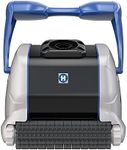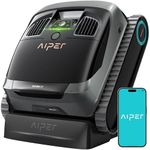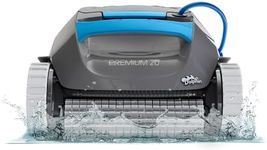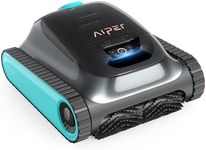Buying Guide for the Best Robot Pool Cleaners
Choosing a robot pool cleaner can make pool maintenance much easier and more efficient. The right model will keep your pool clean with minimal effort from you, but with so many options available, it’s important to understand the key features and how they relate to your specific needs. By focusing on the main specifications, you can find a cleaner that matches your pool size, type, and cleaning preferences, ensuring you get the best performance and value.Pool CompatibilityPool compatibility refers to whether the robot pool cleaner is suitable for your pool’s size, shape, and surface type. Some cleaners are designed for above-ground pools, while others work best in in-ground pools. The surface material—such as vinyl, fiberglass, or concrete—can also affect which cleaner is best. When choosing, make sure the cleaner is rated for your pool’s type and size. If you have a large or irregularly shaped pool, look for models that can handle those dimensions and contours. For smaller or standard-shaped pools, most basic models will suffice.
Cleaning CoverageCleaning coverage describes which parts of the pool the robot can clean, such as the floor, walls, and waterline. Some cleaners only clean the pool floor, while others can climb walls and scrub the waterline. If you want a thorough clean, especially if debris tends to stick to the walls or waterline, choose a model with full coverage. For pools that mostly collect debris on the floor, a simpler model may be enough.
Filtration SystemThe filtration system is how the robot collects and traps dirt, leaves, and debris. Some cleaners have fine filters for small particles, while others have larger baskets for bigger debris. If your pool is surrounded by trees or gets a lot of leaves, a cleaner with a large debris basket is helpful. For pools that get fine dust or sand, look for a model with a fine filter. Some cleaners offer interchangeable filters, which is useful if your debris type changes throughout the season.
Power Source and Cord LengthRobot pool cleaners can be powered by a cord connected to an external power supply or by a rechargeable battery. Corded models need a power outlet nearby and come with cords of varying lengths. Make sure the cord is long enough to reach all areas of your pool without tangling. Battery-powered models offer more freedom of movement but need to be recharged between uses. If your pool is far from a power source or you want to avoid cord management, a battery-powered model may be more convenient.
Cleaning Cycle and Timer OptionsThe cleaning cycle refers to how long the robot runs during each cleaning session, and timer options let you schedule cleanings automatically. Some models have fixed cycles, while others let you choose different durations or set a weekly schedule. If you want to set the cleaner and forget it, look for models with programmable timers. For occasional or manual cleaning, a simple on/off cycle may be enough.
Navigation and Obstacle AvoidanceNavigation and obstacle avoidance determine how well the robot moves around the pool and avoids getting stuck. Basic models may move randomly, while advanced ones use smart navigation to map the pool and clean efficiently. If your pool has steps, ladders, or unusual shapes, a model with advanced navigation will ensure better coverage and fewer interruptions. For simple, open pools, basic navigation may be sufficient.
Ease of MaintenanceEase of maintenance covers how simple it is to clean and care for the robot. Some models have easy-access filter baskets and parts that can be rinsed quickly, while others require more effort to disassemble and clean. If you want a hassle-free experience, look for models with top-loading filters and minimal maintenance requirements. If you don’t mind a bit of extra work, this may be less important.

















